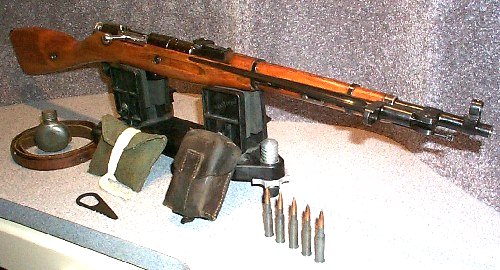It all started a couple of weeks ago. I didn't give Mark much
notice. I called him on a recent weekend morning and told him that I was
planning to head to the movies in about an hour to go see "Enemy at the Gates".
Would he be interested in going with me to see it? He checked with Mama to see
if she had any plans, and I heard her say in the background, "Go ahead."
For those who haven't seen it, the movie is a WWII story about Vassili Zaitsev,
a young and very successful Russian sniper who picked off many Germans during
the siege of Stalingrad. I enjoyed the movie immensely.
Another week passes and I find myself at the gun show. I didn't have a lot of
bread in my pocket, but I bribed the kids to come along with me with the promise
that we would look for some GI Joes. Walking past the always crowded Bear Arms
table, a homely looking rifle with a grand price tag of $89 sits forlornly propped
against the wall behind the table. A rifle for only $89 deserves at least a
second look, and the guy behind the table catches me staring and senses my interest.
I recognized it as a Soviet pattern M44 Mosin Nagant carbine. A couple of years
ago, ads in Shotgun News for new, unissued Polish M44s had caught my eye. The guy
starts telling me that this rifle is a Russian M44, yes, in like-new unissued
condition. It's even still covered in gun storage grease.
Vassili of course, used a Mosin Nagant. His, however was a scoped Model 91/30 long
rifle - not an M44 carbine. But for $89, this was close enough! I paid the man
and brought home my little piece of history!
OK, let's talk a little about the history of the Mosin Nagant. Originally adopted
by Czar Alexander's Imperial Russian Army in 1891, Mosin Nagant rifles chambered
in 7.62x54R remained Russia's main battle rifle through the communist revolution
and two world wars. There were a number of model variations through the years,
culminating in the Model 1944 carbine. The M44 was the end of the line for the
Mosin Nagant and for bolt action rifles as Russia's primary service arm. It was
supplanted by the SKS in 7.62x39 somewhere around 1950. A number of Soviet client
states also manufactured Mosin Nagant variants.
The M44 is characterized by a permanently mounted, side-folding, cruciform bayonet.
Russian doctrine still emphasized massed charges by the troops, and a bayonet was
considered a requirement. However, close quarters fighting in places such as
Stalingrad had proven the need for a handier, shorter carbine, so the attached
folding bayonet was deemed the perfect solution. The M44 measures out to a
compact 40" overall length.
Upon arriving home with my new prize, I learned that my particular specimen was
manufactured in 1946. I worked the rest of the afternoon and well into the evening
totally disassembling the rifle, and wiping every part down with solvent soaked
paper towels, removing the storage grease. I must say that this task wasn't at all
unpleasant. I suppose this task could get old for a dedicated long time collector,
but this is my first military surplus gun. The disassembly, clean up and reassembly
sort of gave me the feeling of working with a kit gun project.
It came with a small selection of original accessories including sling, oil canister,
ammo pouch and cleaning kit.
The bluing on the metal is in 98%+ condition. The bore is absolutely pristine.
After removing the grease, the third solvent-soaked patch came out perfectly clean.
I don't think I've had a new sporting rifle with a bore so nice!
Next, I turned my attention to beautifying the stock. The wood is nothing
special - simply military grade birch with a light stain for color. I gave
it three coats of Watco natural color oil finish, rubbing with fine steel
wool between coats. After letting the oil finish cure for 72 hours, I sprayed
it with two coats of satin finish polyurethane. One more light touch with steel
wool, a final coat of finishing wax and the wood looks great!
Well how does she shoot? So far I've only taken her out once. Shot some
Hungarian softpoints and some Czech FMJ spitzers. The Czech fodder turned in
a 2¾" group at 100 yards - about what I expected from a 55 year old milsurp rifle
shooting milsurp fodder with open sights. I measured velocities in the 2700 to
2800 fps range for 150 gr. projectiles - very much like a .308 Winchester.
Wanting to know more about my M44, I jumped on the Web to see what kind of info
might be out there on these Russian rifles. I found three excellent websites
created by Mosin Nagant collectors. These sites feature many articles about the
care and feeding of the guns and of the history of their use by various countries.
In particular, they go into exquisite detail about both the common and the obscure
variations of Mosin rifles as manufactured by different countries at different times.
The key to the history of your particular rifle lies in the various markings and
cartouches that are stamped in various places all over the rifle. Each mark means
something, and together, they reveal a story about your rifle's history.
For example, the markings on my M44 reveal that it was made in 1946 at the Izhevsk
arsenal. One of the websites lists production numbers for Izhevsk. Mine was one
of 189,027 made that year. My buttstock is engraved with the characters "1.TRZ".
The website says that this is a Yugoslavian post-war cartouche. Made in Russia,
but stockpiled in Yugoslavia.
From a collector's point of view, one of the most important things to look for is
matching serial numbers. This isn't a problem if you find one of these pristine,
un-issued M44s, but it can be a problem for Mosins Nagants that have seen some use.
Serial numbers can be found in five places: Receiver, barrel shank, bolt, magazine
floorplate, and buttplate.
Anyway, the collector websites introduced me to the multitude of Mosin variations.
The very first was the model 1891. Then there was the "Cossack" variation of the
M91; then the "Dragoon" variation (Dragunskaya - just thought that was a neat word);
the model 1907 carbine; the model 91/30 (1930 update to the M1891) which was the
backbone of the Red Army during WW2; the M38 carbine, and finally the M44.
And then there are the Finnish variations, generally considered to be the highest
quality Mosins, made by such well respected names as SAKO, Tikka, and Valmet - and
copies by the Poles, the Hungarians, the Romanians, the - well you get the idea.
What a wonderful world of old rifles! Two of the Mosin collector sites host
message boards, where folks can ask questions, tell tales, and chat about their
passion. One of the messages mentioned that M91/30s were currently on sale at
Big 5 for $50! How much better can this get?
Alright, the Big 5 91/30s were not anywhere near unissued condition. They were
in "good" condition, meaning that the guns were intact, but may be pitted, rusted
and dinged, but not to the point of being unshootable.
The first Big 5 I walked into had two on the rack, but one was already spoken for.
The second had a big chunk of stock wood gouged out, and hanging loose. No thanks.
I went to another store and they had one. It was grimy, dinged, the grooves were
dark and the lands were rounded. The stock wood was splintery, but no chunks were
missing out of it. It had a couple of small arsenal stock repairs.

Mosin Nagant Model 91/30
- After Rehab -
I knew that these $50 91/30s were in generally sad shape, yet I was still interested
in picking one up. Why? I had a lot of fun breaking the M44 down, and cleaning it
up from the inside out. I knew that I would have even more fun doing the same with
one of these "good" condition 91/30s! I was looking for a "project." Besides, I
just like the rakish look of the M91/30. They have a certain kind of "gothic"
elegance. Once again, I paid the man, signed the papers, and brought home an old
Russian rifle.
Both barrel and receiver dates reveal that this old timer was made in 1929. Since
that's before M91/30s were issued, this guy most likely started life as an M91
Dragoon and was later rebuilt to 91/30 specs. The M91 Dragoon is a slightly
shortened M91. The major difference between the Dragoon and the M91/30 are
improved sights.
The "restoration" took a couple of late weeknights, plus one weekend day. I
aggressively sanded down the stock, and laid down a new oil finish. I
cold-reblued all the iron. The buttplate, for example, had no blue remaining.
It was very dinged up, and heavily rusted on the side that faced the stock.
A wire brush chucked into a drill press made short work of the rust. Then I
took a file to the edges to match it up with the stock. I'm telling you, the
handyman in me just loves this stuff! I did what I could with the bore -- pulled
out a lot of black patches without making the bore that much shinier.
It's funny how seeing a movie has opened up this whole new facet of the gun
hobby for me. The tie with history is what really enriches this niche of the
shooting sports.
Mosin Nagants are a very under-appreciated rifle on today's surplus market.
Because of that, they are inexpensive to acquire, and the many variations provide
fertile ground for collecting. Yes, a Mosin rifle collector has been born.
Actually, I'm now up to three, but you'll have to wait for next time to find out
about the other one!
One of the side effects of this new interest, is that it got me asking my mom
some details about family history. My Hispanic last name hides the fact that
I'm European on my mom's side. She was born in the small Baltic nation of
Latvia. Like Gerhard, I too had an Opa. My Opa (my great-grandfather) was a
Russian. He was actually a gate-guard at the Czar's palace in St. Petersburg.
I always thought that I was 3/8ths Latvian and 1/8th Russian, but it turns out
that both Mom's parents were half Latvian, half Russian. And that makes me fully
one-quarter Russian! I never knew!
© Honeywell Sportsman Club. All rights reserved.





